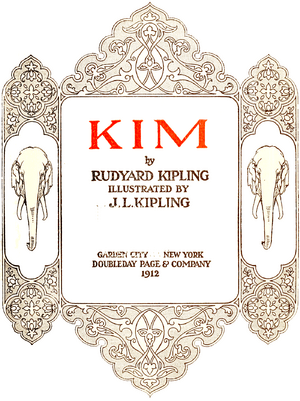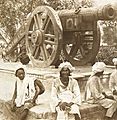Kim (novel) facts for kids

Title page
|
|
| Author | Rudyard Kipling |
|---|---|
| Illustrator | H. R. Millar |
| Country | United Kingdom |
| Language | English |
| Genre | Spy & Picaresque novel, |
| Publisher | McClure's Magazine (in serial) & Macmillan & Co (single volume) |
|
Publication date
|
October 1901 |
| Media type | Print (Serial & Hardcover) |
| Pages | 368 |
| OCLC | 236914 |
Kim is a famous adventure novel written by the English author Rudyard Kipling, who won the Nobel Prize in Literature. It was first published in parts (like a TV series) in magazines from December 1900 to October 1901. The full book came out in October 1901.
The story takes place in India during the late 1800s. It is set against the exciting background of "The Great Game". This was a secret political rivalry between the British and Russian empires in Central Asia. The novel helped make the term "Great Game" well-known. It also showed how big countries competed and used spies.
The book is known for its amazing details about the people, cultures, and many religions of India. It paints a clear picture of India's busy cities, its different beliefs, and the lively markets and roads.
In 1998, Kim was ranked number 78 on the Modern Library's list of the 100 best English novels of the 20th century. In 2003, it was also listed in the BBC's "The Big Read" poll as one of the UK's most loved novels.
Contents
Kim's Adventures: The Story of a Young Spy
Kim (whose full name is Kimball O'Hara) is an orphan. His Irish soldier father and poor Irish mother both died. Kim lives on the streets of Lahore, India, during the time when Britain ruled the country. He makes a living by begging and doing small jobs.
Kim sometimes works for Mahbub Ali, a horse trader from Pashtun. Mahbub Ali is secretly a spy for the British. Kim fits in so well with the local culture that most people don't realize he is white. He carries a packet of papers from his father, given to him by an Indian woman who took care of him.
Meeting the Lama
Kim becomes friends with an old Tibetan lama. A lama is a Buddhist teacher. This lama is on a special journey to find a legendary "River of the Arrow." He believes this river will help him become free from the "Wheel of Things" (the cycle of life and death). Kim becomes his chela, or student, and travels with him.
On their journey, Kim accidentally learns about parts of the Great Game. Mahbub Ali then recruits Kim to deliver a secret message to the head of British intelligence in Umballa. Kim's trip with the lama along the Grand Trunk Road is his first big adventure.
School and Spy Training
By chance, a chaplain (a priest) from Kim's father's army regiment recognizes Kim. He sees Kim's Masonic certificate, which Kim wears around his neck. Kim is then separated from the lama. The lama believes it's best for Kim to go to school. So, Kim is sent to a top English school in Lucknow. The lama, who used to be an abbot (a head of a monastery), pays for Kim's education.
While at school, Kim stays in touch with the lama. He also keeps in contact with his spy connections. During school breaks, he is trained in espionage (spying) by Lurgan Sahib. Lurgan Sahib is a kind jewelry shop owner in Simla. Kim learns how to be a surveyor (someone who maps land).
Kim's Game
As part of his training, Kim plays a game called "Kim's Game" (also known as the Jewel Game). He looks at a tray of mixed objects and has to remember which ones were added or taken away. He also learns how to use disguises and carefully study Indian people. This includes their clothes, behavior, and even small habits, so he can go undercover or spot others in disguise.
Joining the Great Game
After three years of school, Kim gets a government job. This means he can officially start working in the Great Game. Before his job begins, he gets a well-deserved break. Kim rejoins the lama. At the request of Kim's boss, Hurree Chunder Mookherjee, they travel to the Himalayas. Kim's mission is to investigate what some Russian intelligence agents are doing there.
Kim successfully gets maps, papers, and other important items from the Russians. These Russians are trying to cause trouble for British control in the area. Mookherjee pretends to be friends with the Russians, acting as their guide. He makes sure they don't get their lost items back. Kim, with help from porters (people who carry things) and villagers, helps rescue the lama.
The lama realizes he has gone off his path. His search for the River of the Arrow should be in the plains, not the mountains. He tells the porters to take them back. Kim and the lama are cared for and get better after their difficult journey. Kim gives the Russian documents to Hurree. Mahbub Ali also comes to check on Kim, showing he cares.
The lama finds his river and believes he has reached Enlightenment (a state of perfect wisdom). He wants to share this with Kim. The book doesn't say what happens to them next.
Main Characters
- Kimball "Kim" O'Hara – An orphan boy, the main character of the story. He is described as "a poor white, the poorest of the poor."
- Teshoo Lama – An old Tibetan Lama and former abbot. He is on a spiritual journey to find the "River of the Arrow."
- Mahbub Ali – A famous horse trader and a spy for the British.
- Colonel Creighton – A British Army officer who is also a spy.
- Lurgan Sahib – A gem trader in Simla and a master spy who trains Kim.
- Hurree Chunder Mookherjee (Hurree Babu) – A spy from Bengal who works for the British. He is Kim's direct supervisor.
- The Kullu woman (the Sahiba) – An old noble lady from the hills who lives in the plains.
- The Woman of Shamlegh (Lispeth) – She helps Kim and the Lama escape the Russian spies.
- The old soldier – A Sikh officer who was loyal to the British during the Mutiny.
- Reverend Arthur Bennett – The Church of England chaplain of the Mavericks, Kim's father's regiment.
- Father Victor – The Roman Catholic chaplain of the Mavericks.
Famous Places in the Story
- The gun in front of the Lahore Museum is a real cannon called Zamzama. It is sometimes called Kim's gun. Kim sits on it at the beginning of the book.
- The "Gate of the Harpies" in the old city of Lahore, Pakistan, still exists. It is known as "Heera Mandi".
- Kim dreams of a "Red bull in a green field." He later sees this symbol on a military badge in Ambala Cantonment, India.
- The Jang-i-Lat sahib (War Lord/Commander-in-Chief) who visits Colonel Creighton's house is based on a real British general, Field Marshal Lord Roberts.
- St Xavier's School in Lucknow, where Kim studies, is based on the real La Martiniere Lucknow college.
- Lurgan Sahib's small shop in Simla was based on a real shop run by A.M. Jacob.
- The book mentions the Lawrence School, Sanawar when it says, "We'll make a man of you at Sanawar—even at the price o' making you a Protestant."
Other Stories Inspired by Kim
Many authors have been inspired by Kim:
- The first part of Robert A. Heinlein's 1957 novel Citizen of the Galaxy is similar to Kim. It features a clever slave boy who is guided by a spy.
- Poul Anderson's 1985 novel Game of Empire is loosely based on Kim, but set in space.
- Tim Powers' 2001 novel Declare uses Kim for ideas and quotes.
- Steven Gould's 2011 novel 7th Sigma is heavily based on Kim. It features a young boy named Kim who becomes a trained spy.
- T.N. Murari's The Imperial Agent (1989) is a sequel to Kim.
- The town of Kim, Colorado in the United States is named after the book.
Dramatic Adaptations
Kim has been made into films and TV shows:
- A MGM film was released in 1950. It starred Errol Flynn and Dean Stockwell as Kim.
- In 1960, a one-hour TV version of Kim was shown on NBC's Shirley Temple's Storybook.
- A London Films TV film version of Kim was made in 1984. It starred Peter O'Toole and Ravi Sheth as Kim.
Images for kids
See also
 In Spanish: Kim (novela) para niños
In Spanish: Kim (novela) para niños


